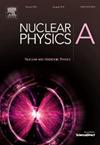Quasifission and deep inelastic collisions competing with superheavy element creation
IF 1.7
4区 物理与天体物理
Q2 PHYSICS, NUCLEAR
引用次数: 0
Abstract
Fusion forming superheavy elements is strongly inhibited by the faster non-equilibrium Deep Inelastic (DIC) and quasifission processes. These have often been considered as distinct processes, but recent measurements for reactions involving heavy nuclei such as 208Pb and lighter suggest that these two processes form a continuum. However, for reactions of heavy ions with actinide nuclei, binary mass-split spectra show reduced yields for fragments lighter than the target, resulting in a peak in yield close to 208Pb. This gives an apparent separation between DIC and quasifission outcomes. The 208Pb peak has generally been attributed to the 208Pb closed shells giving a valley in the potential energy surface, attracting quasifission trajectories. However, recent extensive binary and three-body cross-sections extracted for reactions of 50Ti with actinide nuclides could not be explained in this framework. Rather, the big drop in yield observed for the heavier actinide targets is consistent with sequential fission of heavy deep inelastic/quasifission fragments.
To search for shell effects in quasifission independent of sequential fission, systematics of mass spectra in non-actinide reactions forming actinide compound nuclei were studied. These showed negligible effects of the shells known to cause low energy mass-asymmetric fission of these nuclei. All these results raise questions over the understanding of the effects of closed shells on the quasifission mechanism, and quasifission mass distributions.
准裂变和深度非弹性碰撞与超重元素产生的竞争
快速非平衡深度非弹性(DIC)和准裂变过程强烈抑制了超重元素的聚变形成。这些通常被认为是不同的过程,但最近对涉及重核如208Pb和轻核的反应的测量表明,这两个过程形成了一个连续体。然而,对于重离子与锕系原子核的反应,二元质量分裂谱显示出比目标轻的碎片的产率降低,导致产率峰值接近208Pb。这使得DIC和准分裂结果之间存在明显的分离。208Pb峰值通常归因于208Pb闭合壳层在势能面形成一个谷,吸引准裂变轨迹。然而,最近从50Ti与锕系核素反应中提取的大量二体和三体截面不能在这个框架中解释。相反,在重的锕系元素靶中观察到的产率的大下降与重的深非弹性/准裂变碎片的顺序裂变一致。为了寻找独立于顺序裂变的准裂变中的壳层效应,研究了形成锕系化合物核的非锕系反应的质谱系统。这些结果表明,已知导致这些原子核低能质量不对称裂变的壳层的影响可以忽略不计。所有这些结果对理解闭合壳层对准分裂机制和准分裂质量分布的影响提出了疑问。
本文章由计算机程序翻译,如有差异,请以英文原文为准。
求助全文
约1分钟内获得全文
求助全文
来源期刊

Nuclear Physics A
物理-物理:核物理
CiteScore
3.60
自引率
7.10%
发文量
113
审稿时长
61 days
期刊介绍:
Nuclear Physics A focuses on the domain of nuclear and hadronic physics and includes the following subsections: Nuclear Structure and Dynamics; Intermediate and High Energy Heavy Ion Physics; Hadronic Physics; Electromagnetic and Weak Interactions; Nuclear Astrophysics. The emphasis is on original research papers. A number of carefully selected and reviewed conference proceedings are published as an integral part of the journal.
 求助内容:
求助内容: 应助结果提醒方式:
应助结果提醒方式:


